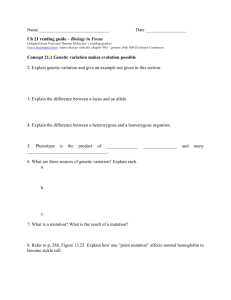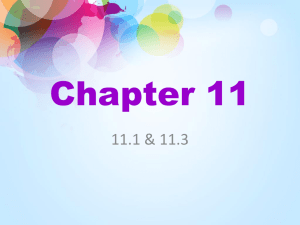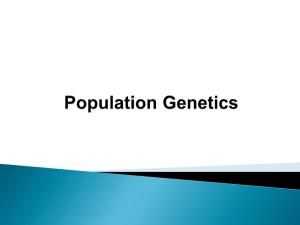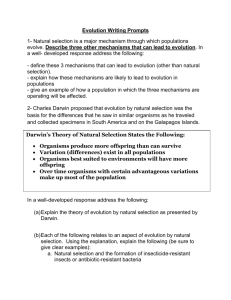PowerPoint Lecture Chapter 11
advertisement
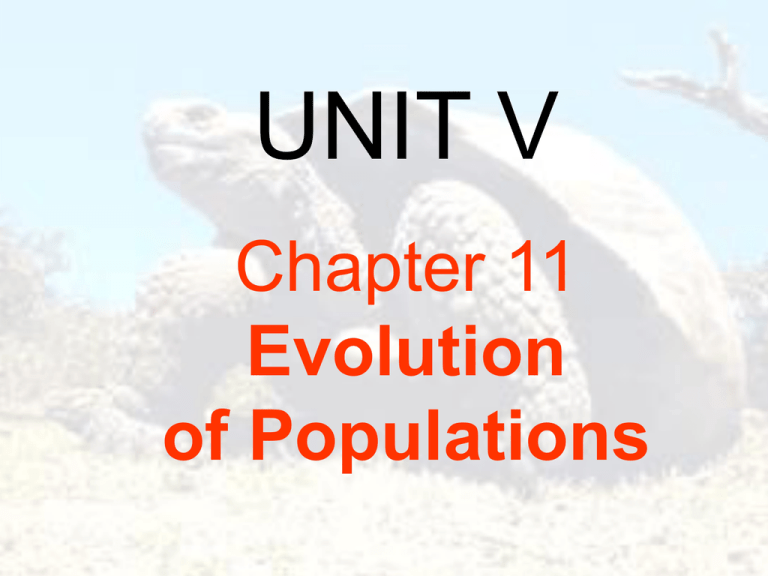
UNIT V Chapter 11 Evolution of Populations UNIT 4: EVOLUTION Chapter 11: The Evolution of Populations I. Genetic Variation Within Populations (11.1) A. Genetic variation in a population increases the chance that some individuals will survive 1. Genetic variation in populations lead to differences in Phenotypes 2. Natural selection acts on phenotype 3. The greater the range in phenotypes, the more likely some individuals can survive changing environment a. Gene Pool- genetic variation stored in population b. Each allele exists at a certain frequency gene frequency B. Genetic variation comes from several sources 1. Mutation- random change in organisms DNA a. can form new allele b. Mutations in reproductive cells can be passed on c. Increases genetic variation in gene pool 2. Recombination- new allele combination form in offspring a. Meiosis-new combinations of parents alleles b. Crossing over increases variation II. Natural Selection in Populations (11.2) A. Natural selection acts on distribution of traits 1. Normal distributiongives classic “bell-shaped” curve 2. Environmental conditions can change and a certain phenotype may become an advantage B. Natural Selection can change the distribution of a trait in one of three ways 1. Microevolution-observable change in allele frequency of a population over time a. Occurs on small scale within single population b. Natural selection can change distribution of a trait along 3 paths (directional, stabilizing, or disruptive selection 2. Directional Selection- causes shift in a populations phenotypic distribution a. An extreme phenotype that was once rare is now more common b. Mean value of a trait shifts in direction of the more advantageous phenotype c. Lead to rise in drug-resistant bacteria 3. Stabilizing Selection- the intermediate phenotype is favored and becomes more common. a. Decreases genetic diversity b. Extreme phenotypes may be lost 4. Disruptive Selection- occurs when both extremes are favored and intermediate are selected against a. Intermediate forms selected against b. Can lead to formation of new species III. Other Mechanisms of Evolution (11.3) A. Gene flow is the movement of alleles between populations 1. Gene flow- movement of alleles from one population to another a. Increases genetic variation of receiving population b. Gene flow between populations keeps gene pools similar c. Less gene flow can create genetically different populations d. Lack of gene flow increases chance that two populations will evolve into different species B. Genetic drift is a change in allele frequencies due to chance 1. Small populations are more likely to be affected by chance 2. Genetic Drift- changes in allele frequencies due to chance (Two ways this occurs) a. Bottleneck Effect- genetic drift that occurs after an event (e.g. overhunting) b. Founder Effect- genetic drift that occurs after a small number of individuals colonize a new area 3. Effects of Genetic Drift a. Lose of genetic variation- ability of group to adapt to changing environment is lessened. b. Lethal alleles may become more common in gene pool due to chance alone Genetic drift has been observed in some small human populations that have become isolated due to reasons such as religious practices and belief systems. For example, in Lancaster County, Pennsylvania, there is an Amish population of about 12,000 people who have a unique lifestyle and marry other members of their community. By chance, at least one of the original 30 Amish settlers in this community carried a recessive allele that results in short arms and legs and extra fingers and toes in offspring. Because of small gene pool, many individuals inherited the recessive allele over time. Today, the frequency of this allele among the Amish is high (1 in 14 rather than 1 in 1000 in the larger population of the U.S.) C. Sexual selection occurs when certain traits increase mating success 1.Mating can have important effect on evolution of population a. Males make many sperm continuously (value of each relatively small) b. Females more limited in number of offspring can produce (each investment more valuable, and they want a good return) 2. Sexual selection- when certain traits increase mating success a. Certain traits can become very exaggerated over time through sexual selection b. These traits for mating success not always adaptive for survival of the individual IV. Hardy-Weinberg Equilibrium (11.4) A. Hardy-Weinberg equilibrium describes populations that are not evolving 1. Said genotype frequencies stay the same over time as long as certain conditions are met. (5 conditions) a. Very large populations (no genetic drift can occur) b. No emigration or immigration (no gene flow can occur) c. No mutations (no new alleles can be added tothe gene pool) d. Random mating (no sexual selection can occu e. No natural selection (all traits must equally aid in survival) B. The Hardy-Weinberg equation is used to predict genotype frequencies in a population 1. Used in simple dominant-recessive systems 2. Shows values that would exist in population in equilibrium 3. Use equation (if calculated frequencies match actual frequencies, then population in equilibrium) p 2 pq q 1 2 2 C. There are 5 factors that can lead to evolution (populations not in Hardy-Weinberg equilibrium are evolving) 1. Genetic drift (allele frequencies change due to chance) 2. Gene flow (movement of alleles-emigration and immigration) 3 Mutation (New alleles form through mutation and create genetic variation) 4. Sexual selection (certain traits improve mating success) 5. Natural selection (certain traits advantageous to survival. Alleles for these traits increase in frequency) V. Speciation Through Isolation (11.5) A. The isolation of populations can lead to speciation 1. Speciation- the rise of two or more species from one existing species 2. Reproductive isolation- when members of different populations can no longer mate successfully with one another) B. Populations can become isolated in several ways 1. Behavioral barriers a. Behavioral isolation- isolation caused by differences in courtship or mating behavior) b. Chemical scents, courtship dances, courtship songs, sexual signals used to attract mates 2. Geographic barriers a. Geographic isolation- involves physical barriers that divide populations b. Include mountains, rivers, dried lakebeds, etc. c. Over time isolated populations become genetically different 3. Temporal Barriers a. Temporal Isolation- Timing prevents reproduction between populations b. Reproductive periods may change and can lead to speciation VI. Patterns of Evolution (11.6) A. Evolution through natural selection is not rando 1. Environment controls the direction taken by natural selection 2. The response of species to environmental challenges and opportunities is not random a. Convergent Evolution- evolution towards similar characteristics in unrelated species b. Divergent Evolution- related species evolve in different directions and become increasingly different B. Species can shape each other over time 1. Coevolution- two or more species evolve in response to changes in each other 2. Evolutionary arms race- coevolution can occur in competitive relationships C. Species can become extinct 1. extinction- elimination of a species from Earth 2. Background extinctions- extinctions that occur continuously at very low rate 3. . Mass extinction- more rare, but more intense a. Can occur on global level b. Thought to occur due to catastrophic events (e.g. ice age, asteroid impact) D. Speciation often occurs in patterns 1. Punctuated equilibrium- bursts of evolutionary activity a. Episodes of speciation occur suddenly b. Followed by periods of little change 2. Adaptive radiationDiversification of one ancestral species into many descendent species Chapter 11 The Evolution Of Populations Natural selection acts directly on a. alleles. b. genes. c. phenotypes. d. mutations. Natural selection acts directly on a. alleles. b. genes. c. phenotypes. d. mutations. Interbreeding among members of a population a. alters the relative frequencies of alleles in the gene pool. b. alters the different types of alleles in the gene pool. c. does not alter the different types of alleles in the gene pool. d. does not alter genetic variation in the population. Interbreeding among members of a population a. alters the relative frequencies of alleles in the gene pool. b. alters the different types of alleles in the gene pool. c. does not alter the different types of alleles in the gene pool. d. does not alter genetic variation in the population. Interbreeding among members of a population a. alters the relative frequencies of alleles in the gene pool. b. alters the different types of alleles in the gene pool. c. does not alter the different types of alleles in the gene pool. d. does not alter genetic variation in the population. In genetic drift, allele frequencies change because of a. mutation. b. chance. c. natural selection. d. genetic equilibrium. In genetic drift, allele frequencies change because of a. mutation. b. chance. c. natural selection. d. genetic equilibrium. Mutations do NOT always affect a. genotype. b. phenotype. c. only single-gene traits. d. only polygenic traits. Mutations do NOT always affect a. genotype. b. phenotype. c. only single-gene traits. d. only polygenic traits. Populations are separated by barriers such as rivers, mountains, or bodies of water in a. temporal isolation. b. geographic isolation. c. behavioral isolation. d. natural selection. Populations are separated by barriers such as rivers, mountains, or bodies of water in a. temporal isolation. b. geographic isolation. c. behavioral isolation. d. natural selection. One of the conditions required to maintain genetic equilibrium is a. natural selection. b. mutations. c. nonrandom mating. d. no movement into or out of the population. One of the conditions required to maintain genetic equilibrium is a. natural selection. b. mutations. c. nonrandom mating. d. no movement into or out of the population. The genetic equilibrium of a population can be disturbed by each of the following EXCEPT a. nonrandom mating. b. movement into and out of the population. c. a large population size. d. mutations. The genetic equilibrium of a population can be disturbed by each of the following EXCEPT a. nonrandom mating. b. movement into and out of the population. c. a large population size. d. mutations. An example of a polygenic trait in humans is a. widow's peak. b. absence of widow's peak. c. height. d. ABO blood type. An example of a polygenic trait in humans is a. widow's peak. b. absence of widow's peak. c. height. d. ABO blood type. All members of a population a. are temporally isolated. b. are geographically isolated. c. are able to interbreed. d. have identical genes. All members of a population a. are temporally isolated. b. are geographically isolated. c. are able to interbreed. d. have identical genes. Most inheritable differences are due to a. mutation. b. chemicals in the environment. c. gene shuffling. d. radiation. Most inheritable differences are due to a. mutation. b. chemicals in the environment. c. gene shuffling. d. radiation. The combined genetic information of all members of a population is the population's a. relative frequency. b. phenotype. c. genotype. d. gene pool. The combined genetic information of all members of a population is the population's a. relative frequency. b. phenotype. c. genotype. d. gene pool. The situation in which allele frequencies remain constant is called a. evolution. b. genetic drift. c. genetic equilibrium. d. natural selection. The situation in which allele frequencies remain constant is called a. evolution. b. genetic drift. c. genetic equilibrium. d. natural selection. A change in a sequence of DNA is a a. recombination. b. polygenic trait. c. single-gene trait. d. mutation. . A change in a sequence of DNA is a a. recombination. b. polygenic trait. c. single-gene trait. d. mutation. . The actual distribution of phenotypes for a typical polygenic trait a. is best expressed as a bar graph. b. forms a bell-shaped curve. c. exactly matches Mendelian ratios. d. is similar to the distribution of phenotypes of a single-gene trait. . The actual distribution of phenotypes for a typical polygenic trait a. is best expressed as a bar graph. b. forms a bell-shaped curve. c. exactly matches Mendelian ratios. d. is similar to the distribution of phenotypes of a single-gene trait. . Gene shuffling includes the independent movement of chromosomes and a. the expression of polygenic traits. b. the expression of single-gene traits. c. crossing over. d. mutation. Gene shuffling includes the independent movement of chromosomes and a. the expression of polygenic traits. b. the expression of single-gene traits. c. crossing over. d. mutation. According to the Hardy-Weinberg principle, genetic equilibrium would be encouraged in a population of deer mice, Peromyscus maniculatus, if a. the population size decreases. b. mutation rates within the population rise. c. no natural selection occurs. d. frequent movement both into and out of the population occurs. According to the Hardy-Weinberg principle, genetic equilibrium would be encouraged in a population of deer mice, Peromyscus maniculatus, if a. the population size decreases. b. mutation rates within the population rise. c. no natural selection occurs. d. frequent movement both into and out of the population occurs. Which factor would most likely cause evolution in a large population? a. the production of large numbers of offspring within the population b. the occurrence of nonrandom mating within the population c. the absence of movement into and out of the population d. the absence of mutations within the population Which factor would most likely cause evolution in a large population? a. the production of large numbers of offspring within the population b. the occurrence of nonrandom mating within the population c. the absence of movement into and out of the population d. the absence of mutations within the population Genetic drift tends to occur a. in very large populations. b. in small populations. c. only in new species. d. following stabilizing selection. Genetic drift tends to occur a. in very large populations. b. in small populations. c. only in new species. d. following stabilizing selection. Which factor most favors speciation? a. ecological competition b. geographic isolation c. gene pool stability d. a halt in evolution Which factor most favors speciation? a. ecological competition b. geographic isolation c. gene pool stability d. a halt in evolution A new species cannot form without a. different mating times. b. geographic barriers. c. different mating songs. d. reproductive isolation. A new species cannot form without a. different mating times. b. geographic barriers. c. different mating songs. d. reproductive isolation. The rapid evolution of the surviving fragment of a population of chipmunks after a forest fire a. must be caused by genetic drift. b. cannot be caused by genetic drift. c. might be caused by genetic drift. d. none of the above The rapid evolution of the surviving fragment of a population of chipmunks after a forest fire a. must be caused by genetic drift. b. cannot be caused by genetic drift. c. might be caused by genetic drift. d. none of the above A mutation that affects an organism's fitness must therefore affect the organism's a. genotype. b. phenotype. c. ability to reproduce. d. all of the above A mutation that affects an organism's fitness must therefore affect the organism's a. genotype. b. phenotype. c. ability to reproduce. d. all of the above Sexual reproduction a. affects inheritable variation less than does mutation. b. produces many different genotypes. c. does not affect the number of phenotypes produced. d. alters the relative frequency of alleles in a population. Sexual reproduction a. affects inheritable variation less than does mutation. b. produces many different genotypes. c. does not affect the number of phenotypes produced. d. alters the relative frequency of alleles in a population. The Galápagos finches are an excellent example of a. speciation. b. genetic equilibrium. c. stabilizing selection. d. selection on single-gene traits. The Galápagos finches are an excellent example of a. speciation. b. genetic equilibrium. c. stabilizing selection. d. selection on single-gene traits. The American toad breeds earlier in the spring than the Fowler's toad does. Therefore, they do not interbreed, even though they often live in the same habitat. What can be inferred from this information? a. The two species do not interbreed because of geographic isolation. b. The two species do not interbreed because of temporal isolation. c. The two species undergo no ecological competition. d. Fowler's toad has a higher rate of survival than the American toad does. The American toad breeds earlier in the spring than the Fowler's toad does. Therefore, they do not interbreed, even though they often live in the same habitat. What can be inferred from this information? a. The two species do not interbreed because of geographic isolation. b. The two species do not interbreed because of temporal isolation. c. The two species undergo no ecological competition. d. Fowler's toad has a higher rate of survival than the American toad does.


